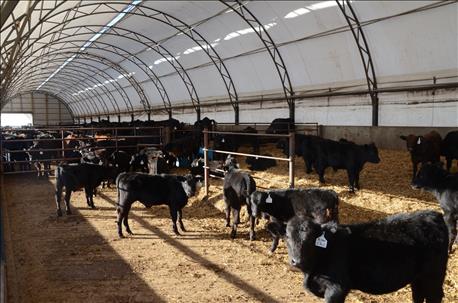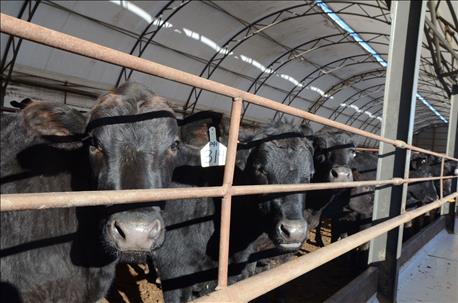
In Daryl Crook's part of the state, pasture acres are few and far between. For the state as a whole, pasture and rangeland acres are plentiful – permanent pasture acres comprise around half of the state's total ag land, according to USDA Ag Census data from 2012. However, in Butler County, pasture acres can be hard to come by. Of the 370,086 total farm acres in Butler County, 306,621 are in cropland.
"Finding pasture in eastern Nebraska is incredibly difficult with the demand for land to grow corn and soybeans. The further west you go in Nebraska, there's more pasture available, but the price of that pasture is not feasible for me," Crook says. "Having an ethanol plant nearby in Columbus, we have one of the highest bids for corn locally. Every acre that can be planted to corn is planted to corn."
So, instead of raising cow-calf pairs on pasture, Crook has been raising cow-calf pairs under roof for nearly nine months, using a building from Hoop Beef System, LLC.

COMFORTABLE CATTLE: Ridge ventilation removes moisture by bringing air in and removing it through the sides and the roof, keeping cattle cool in summer and dry during winter. Because the stresses are reduced, feed requirements are typically lower, says Daryl Crook.
"I talk to producers from North Dakota to Kentucky and Tennessee, the whole Corn Belt and beyond, and the lack of pasture availability and affordability is one of the biggest reasons for not expanding the cow herd," Brent Bryant, managing director at Hoop Beef System, LLC and Grand Meadow Feeders of Washta, Iowa. "That's where this system comes in. It's an alternative to pasture for the producer who wants to expand the cow herd, which we need to do in the U.S. It's a great place for somebody who's bringing a son or a daughter into the operation. It allows them to take advantage of the resources we have in the Midwest – abundant cornstalks, distillers, and right now, cheap corn."

RIGHT GENETICS FOR THE JOB: Crook is using genetics designed specifically for this environment – Hoop Beef System Next Generation females, Gelbvieh-Jersey F1 cross heifers bred with Angus bulls. Brent Bryant explains this brings a smaller-framed heifer with lower feed requirements, great docility, calving ease and mothering ability.
A different kind of management
But this system takes a different kind of management compared to raising pairs on pasture. It means tending to cows and calves every day. "It's not like turning 200 cows out on to pasture for five months and seeing them once a week," Crook says. "You're there at the bunk every single day."
Because Crook and Sellers are interacting with pairs every day, it doesn't take long for cattle to get used to people – they're docile, and easy to handle. "These animals have all been bred in this environment. If you put any animal in this environment, they'll be used to people after a few months," says herdsman Chad Sellers.
Interacting with cattle every day and feeding them at the bunk allows Crook to control intake and cater to nutrient needs through a consistent diet of corn, corn stalks, and wet distillers. After weaning, diets can be adjusted accordingly to meet the needs of dry cows and weaned calves. Meanwhile, weaning is low-stress, similar to fenceline weaning, and calves are already bunk-broke.
Because Crook has more control of intake, it's easy to treat cattle through feed or water when needed. Crook uses a water delivery system similar to those in dairy and hog facilities. So, he can deliver the right amount of water to each group. The building's layout also makes it easy to sort off cows to treat individually.
Having a roof overhead, along with ridge ventilation to keep cattle cool in summer and dry in winter, means less stress on the animal. Because the stresses are reduced, feed requirements are typically lower, Crook notes. "By taking the mud out from under their hooves, the sun off their back, and most importantly, keeping them dry, their requirements to maintain are lowered significantly," Crook says. "Cattle outside in the cold, wet weather are using feed just to maintain body temperature. These girls in the barn have a consistent level of nutrition rather than having highs and lows."
A closed loop system
This system ensures cattle utilize all of the resources and prevents them from wasting feed – an advantage over turning them on to corn stalks, where they can selectively graze, Crook says. "You can put the cattle out on stalks and graze for a couple months, or you can bale all the corn stalks and feed them for a year," Crook says. "If they're out on cornstalks, you can't control what they're grazing. Here you can feed what they need on a daily basis."
Meanwhile, manure from the building is applied uniformly to feed the corn that feeds the cattle. "It's a closed loop of producing the grains and the roughage, capturing the value of that manure, bringing it back in our operation to improve our soils," Bryant says. "If we manage that circle better, not only are we leaving a better cattle operation for our children, but we're leaving better soil for improved crop land."
"I like the idea of the full, green circle." Crook says. "I raise corn that is hauled to the ethanol plant. I buy back wet distillers, I bale the cornstalks and feed it to the livestock, and manure goes back on the corn field as fertilizer. This way, I know I'm not wasting anything."
You can read more about the Hoop Beef System and Crook's operation in the February Nebraska Farmer.
About the Author(s)
You May Also Like






